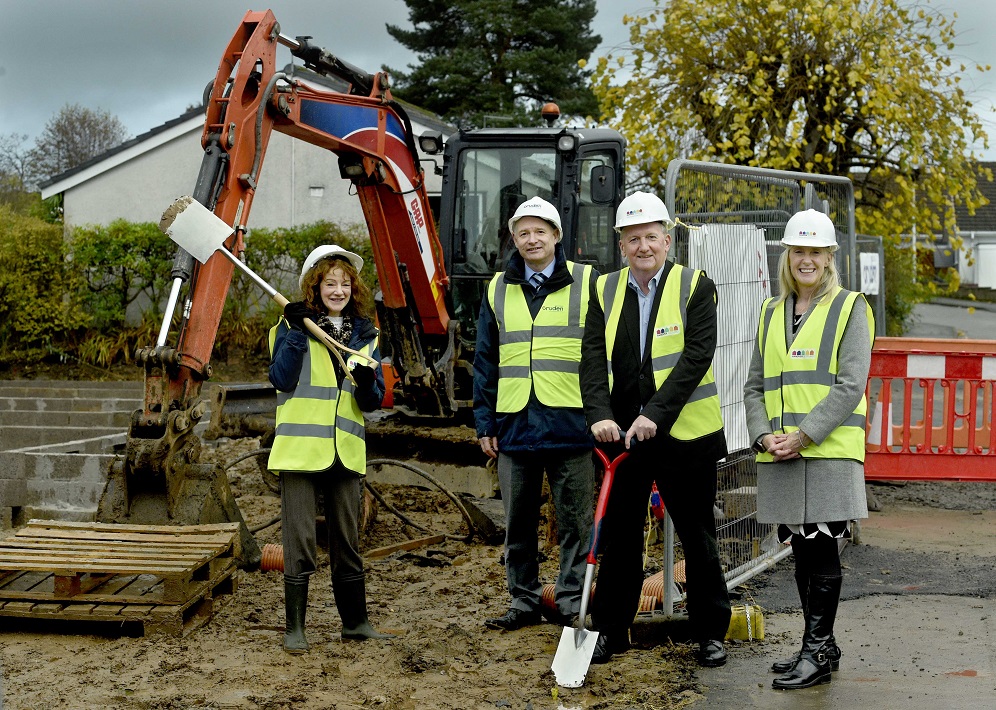Work starts on Drymen Passivhaus social housing development
An official sod-cutting ceremony has been carried out in Drymen, Stirlingshire to mark the start of one of Scotland’s first social housing developments to be built to Passivhaus standards as Cruden Building (West) builds 15 affordable and innovative new homes on behalf of Hanover (Scotland).
About this development:
- Authority:Loch Lomond and the Trossachs
- Type:Residential
- Applications:
- Team:ECD Architects (architect), TCS Construction Consultant (consultant), Cruden Group (developer)

(from left) Angela Currie (Hanover), Alex Rowley MSP, Gordon Lee (Cruden) and Julia Fitzpatrick (Hanover)
The eco-friendly new development in Conic Way and Montrose Way will use up to 90% less energy for heating and cooling and up to 70% less energy than conventional buildings through measures including solar photovoltaics on the roof and triple glazed windows.
These highly sustainable homes will replace the original Drymen housing which was the first development that Hanover (Scotland) owned when it became independent in 1979. The existing tenants will move into new terraced bungalows and two-story semi-detached homes.
The ventilation systems installed in Passivhaus homes means that residents will benefit from a constant supply of fresh air whilst maintaining a comfortable indoor air temperature. The high-performance insulation and windows also make such buildings extremely quiet, and homes will be surrounded by a wildflower meadow to further improve biodiversity.
The event was attended by Alex Rowley MSP, who is launching a consultation on legislation that would see all new-build housing meet the internationally recognised Passivhaus standard.
Commenting on work starting at the new development, he said: “Fuel poverty is a blight that has long plagued Scotland, heating costs continue to rise, and we are now in the midst of a climate crisis that demands action to be taken to mitigate the worst effects of catastrophic climate change. This all shows why we need to change the way we build our housing.
“The cheapest, and most sustainable, energy is the energy you do not use in the first place. That is why building to the Passivhaus standard is so important.
“I am delighted to see work starts on Hanover’s first Passivhaus social housing development and hope that in future we see many more such projects until all new build housing is built to this standard.”

Angela Currie, chief executive of Hanover Scotland, said: “Over the 40 years since it was created, Hanover has been at the forefront of providing innovative care and housing to meet varying needs and supporting residents to experience full and active lives. From the very beginning, we have sought to develop progressive models of housing for older people and to encourage innovative housing design.
“By implementing Passivhaus standards at our development in Drymen, we will be building very energy efficient homes with hugely reduced carbon emissions.
“For our residents, this will mean significantly reduced energy bills and homes that are comfortable, healthy and affordable. Passivhaus standard construction will allow residents to keep their homes warm without worrying about the cost and with the added benefit of knowing that the approach is beneficial to the environment.”
Gordon Lee, director of Cruden Building (West), said: “Protecting the environment and building sustainably has never been so important and Cruden is delighted to begin work on this important development for Hanover within Loch Lomond & Trossachs National Park. As well as building these highly energy-efficient, green homes which make a huge difference to local residents, we will also be bringing a range of community benefits, including employment and training opportunities to this area.”
This development was featured in the Scottish Construction Now COP26SCN showcase of the social housing sector’s efforts to combat climate change.

















